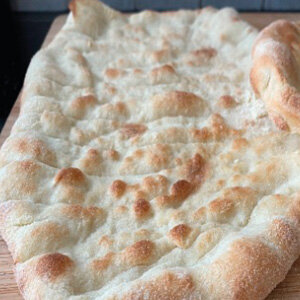
Produção de Pinsa
PINSA PRODUCTION: FROM TRADITIONAL PROCESS TO HIGH-END INDUSTRIAL OUTPUT
Pinsa, an Italian delicacy invented in the Roman Empire that is now crossing borders and making its way to the top of bakery charts around the world. Originally produced by hand, Rademaker transformed this production process into an industrial pinsa production solution while maintaining the crispy crust, airy structure and natural ingredients of this exquisite, ancient tasting bread type.
USP's
- Efficient pinsa producing
- Dough friendly pinsa processing
- Capacities varying from 400 kg/882 lb to 6.000 kg/13,227 lb dough per hour
- Flexible production system
TRANSFORMING PINSA PRODUCTION TO INDUSTRIAL SCALE
With our Pinsa production system, bakeries are capable to produce consistent, high quality pinsa at large output. Capacities range from 400 kg/ 882 lb to 6.000 kg/ 13,227 lb dough per hour, depending on the demands of the bakery.

DOUGH FRIENDLY PINSA PROCESSING
After mixing and fermentation of the pinsa dough, dough batches are placed into the Rademaker pre-sheeter. The dough structure that is created in the mixing process is kept intact due to the dough friendly processing steps. Depending on the desired capacity a Double-chunking Sheeting System (DSS) or Dynamic Pre-Sheeter (DPS) will be used. Both systems are specially designed for producing artisan bread dough types like pinsa dough. This module creates a consistent pinsa dough sheet, keeping the dough structure intact. Producing other bread types on the same production line is possible as well because Rademaker pre-sheeters can handle a wide variety of dough types.
After pre-sheeting the pinsa dough sheet is gently reduced by a combination of reduction stations. When the pinsa dough reached the required dough thickness, it either receive inline proofing before product cutting or is cut into products. Then the pinsa’s are shortly baked in a high temperature stone floor oven. The excess dough can be transported back into the production process, making sure there is no waste of dough. After baking, the pinsa’s go to the freezer and packaging, after which they are delivered to the restaurants or shops. There the pinsa’s are topped, baked again and served to the customer as high-quality products.
MORE INFORMATION?
Interested in our Pinsa production line? Contact via +31 (0)345 543 543 or send an email to sales@rademaker.nl. We are happy to tell you more about pinsa manufacturing with our production line.

PINSA RECIPE FEATURES
Pinsa is a type of pizza dough, originally pressed by hand. But while traditional pizza dough is usually made with only wheat flour, pinsa is made with a mix of non-GMO flours: wheat, soy and rice flours. Soya flour makes the dough crunchy, rice flour helps retain water and makes it easy to bake. And sourdough or biga is added for a delicate flavor. Also, the hallmark of pinsa is the lower amount of yeast.
Moreover, pinsa dough is more hydrated than traditional pizza dough. Whereas pizza dough normally contains 53 to 65% water, pinsa dough can contain 75 to 85% water.
In addition, the pinsa dough requires a long proofing time of about 72 hours. And likewise, there are differences in baking - because of the high moisture content of the dough, the pinsa is baked in two stages: first the base is baked, called par-baking. For the industrial process, the par-baked pinsa is then cooled down, packed and frozen. The pinsa is then transported towards the shop or restaurant, after which it is defrosted, topped and baked in total.

PINSA AS A HEALTHY ALTERNATIVE FOR PIZZA
The combination with a mixture of wheat, soya and rice flour, a large amount of water and a long proofing time makes pinsa a healthier alternative to pizza. The high percentage of water and the long proofing time make the pinsa dough easy to absorb in the human body. In addition, because of the same high-water content, a correspondingly lower amount of flour is added to the dough and, as a result, it contains fewer carbohydrates and, therefore, fewer calories. In the end, we get a GMO-free product with no added sugars, no added saturated fats, 100% less cholesterol and ⅔ less gluten.
Thus, based on a recipe invented during the prosperity of the Roman Empire, pinsa, along with the Colosseum and the Pantheon, logically takes its place in history. And nowadays pinsa is gaining industrial scale to take its place in consumers' hearts for probably a long time to come.
Interested in our Pinsa production line? Contact via +31 (0)345 543 543 or send an email to sales@rademaker.nl. We are happy to tell you more about pinsa manufacturing with our production line.


